Exploring the Future of Healthcare Mobile Apps and Marketing

A woman couldn’t sleep as her chronic back pain was flaring up again, and she’d been putting off finding a new specialist since moving cities six months ago. At 2 AM, instead of lying there frustrated, she pulled out her phone. Twenty minutes later, she’d found a pain management clinic, read through patient reviews, confirmed they accepted her insurance, and booked an appointment for the following week. No phone calls during business hours. No waiting on hold while juggling work meetings. Just the care she needed, accessible when she actually had time to think about it.
his isn’t some distant future. It’s happening right now in practices across the country—while others are still wondering if mobile health apps are ‘just another fad.’
The reality? Healthcare technology has reached a tipping point. Patients aren’t just comfortable with digital tools—they’re expecting them. The pandemic didn’t create this shift; it simply accelerated what was already inevitable. Today’s patients Google their symptoms at 2 AM, research treatment options during lunch breaks, and yes, they download apps to manage everything from medication reminders to chronic conditions.
But here’s what most practice management articles won’t tell you: the technology itself isn’t the game-changer. It’s the human connection these tools can either strengthen or completely destroy.
The Real Story Behind Healthcare’s Mobile Revolution

Walk into any coffee shop and you’ll see it—people of all ages managing their lives through their phones. They’re ordering food, coordinating carpools, tracking fitness goals—and increasingly, taking charge of their health. The 67-year-old checking her blood pressure readings. The busy executive scheduling his preventive care appointment. The college student accessing mental health resources she couldn’t find anywhere else.
These aren’t “tech-savvy millennials.” They’re your patients, and they’re already living in a mobile-first world whether your practice is ready or not.
The practices thriving in this environment aren’t necessarily the ones with the biggest budgets or the newest gadgets. They’re the ones who understand that technology should amplify their care, not replace it. They’ve figured out how to use mobile tools to spend more meaningful time with patients, not less.
Beyond the Buzzwords: What Actually Matters
Every week brings new announcements about AI diagnostics, blockchain medical records, or revolutionary telehealth platforms. Most of it is noise. What matters is surprisingly simple: can your patients easily access the care they need, when they need it, in a way that feels natural and trustworthy?
The practices seeing real results focus on three core areas:
- Accessibility that doesn’t sacrifice quality. This means appointment scheduling that works at midnight, prescription refills that don’t require phone tag, and educational resources that patients can actually understand and use.
- Communication that feels human. Healthcare automation or automated appointment reminders are helpful. Chatbots that can answer basic questions save time. But the moment a patient needs genuine support, they want to connect with a real person who knows their story.
- Care coordination that follows the patient home. The most powerful mobile health tools aren’t fancy—they’re the ones that bridge the gap between clinic visits. Medication tracking, symptom monitoring, recovery guidance that helps patients feel confident in their care decisions.
The Marketing Challenge Nobody Talks About
Here’s the uncomfortable truth: you could have the most innovative patient care technology in your city, but if the right people don’t know about it, it might as well not exist.
Traditional healthcare marketing—the yellow pages ads, the community health fair booths, even the basic website—wasn’t built for a world where patients research their options at 11 PM in their pajamas. Today’s patients are actively searching for solutions to their health challenges. They’re reading reviews, comparing options, and making decisions based on whether a practice seems to understand their specific needs.
This creates an opportunity for practices willing to think differently. Instead of competing on generic claims about “quality care” or “experienced physicians,” forward-thinking practices are connecting with patients around specific problems they’re passionate about solving.
The cardiologist who specializes in helping active professionals manage heart health without giving up the careers they love. The family practice that’s perfected chronic pain management for patients who’ve been dismissed by other providers. The mental health clinic that’s figured out how to support patients through both therapy and practical life changes.
What Mobile-First Patients Actually Expect
Today’s healthcare consumers don’t just want digital options—they expect them to work as smoothly as ordering takeout or booking an Uber. This isn’t about age demographics anymore. It’s about life circumstances that demand flexibility.
Imagine a marketing director and mother of two who also coordinates care for her father with Parkinson’s. Between school pickups and board meetings, she needs to manage three different medical schedules. When she can check appointment availability at 10 PM, verify insurance coverage without playing phone tag, and receive appointment reminders that actually help her prepare (not just “remember your appointment tomorrow”), healthcare feels manageable instead of overwhelming.
Or consider a freelance graphic designer whose income depends on project deadlines. He can’t spend Tuesday afternoon on hold with a receptionist, but he can absolutely handle scheduling, prescription refills, and follow-up questions through secure messaging during his workflow breaks.
These patients expect four core experiences:
- Instant accessibility without sacrificing quality. They want to book appointments outside business hours, but they also want confirmation that their insurance is accepted and their specific needs can be addressed.
- Communication that respects their time. Two-way messaging that gets real answers. Appointment reminders that include prep instructions. Test results delivered with context, not just numbers.
- Transparency that builds trust. Clear pricing information upfront. Provider availability shown in real-time. No hidden fees or surprise requirements discovered at check-in.
- Technology that feels human. Error messages that offer solutions, not just warnings. Interfaces that acknowledge when something is urgent versus routine. Design choices that reduce anxiety rather than create it.
The practices succeeding with mobile-first patients understand that speed alone isn’t enough. The technology needs to feel like it was designed by people who’ve actually been sick, stressed, or scared.
Mobile App Features That Actually Help Small Practices

The healthcare technology market is flooded with enterprise solutions that promise to revolutionize everything. Most small practices don’t need revolution—they need evolution. The most effective mobile features are often the simplest ones, executed well.
- Electronic prescription management tops the list for good reason. When patients can request refills through an app and receive notifications when prescriptions are ready, it eliminates dozens of phone calls per week. The time savings compound quickly for busy practices.
- Digital appointment check-ins solve multiple problems simultaneously. Patients complete paperwork on their own devices, reducing waiting room crowding and front desk bottlenecks. Insurance verification happens before the appointment, not during it. Staff can focus on patient care instead of data entry.
- Secure messaging portals transform routine follow-ups. Post-procedure instructions, medication questions, and appointment scheduling discussions move out of phone calls and into organized, searchable conversations. Patients get faster responses to non-urgent questions, and providers can respond when convenient.
- Patient education modules customized to your practice’s specialties create ongoing value. Instead of printing handouts that get lost, patients access relevant information through the app. A dermatology practice might include skincare routine trackers. An orthopedic clinic could offer physical therapy exercise videos.
The key insight? You don’t need to build everything from scratch. The most successful small practices choose one or two features that address their biggest operational pain points, implement them well, and expand gradually. A perfectly executed appointment booking system beats a half-finished comprehensive platform every time.
Focus on tools that save time for both patients and staff, integrate cleanly with your existing workflows, and actually get used consistently. Fancy features that sit unused help nobody.
How to Vet Healthcare App Vendors
The healthcare app marketplace is full of polished sales presentations and impressive demo videos. The reality behind medical marketing is often less glamorous. Smart practices approach vendor selection with healthy skepticism and specific criteria.
- HIPAA compliance isn’t negotiable, but it’s also not automatic. Ask for specific documentation about data encryption, server security, and breach protocols. If a vendor can’t provide detailed compliance information immediately, that’s a red flag. You’re not being overly cautious—you’re protecting your practice and your patients.
- Integration capabilities determine whether an app becomes useful or becomes a headache. If the mobile solution can’t communicate with your existing practice management system, you’ll create duplicate work instead of reducing it. Request a technical integration demo using sample data that mirrors your actual workflows.
- Customization options matter more than you might expect. Every practice has unique operational quirks. Can the app accommodate your specific appointment types, insurance verification processes, or specialty requirements? Generic solutions often create more problems than they solve.
- Ongoing support and training separate good vendors from great ones. Ask about implementation timelines, staff training programs, and technical support availability. A vendor that disappears after the initial setup will leave you struggling with adoption challenges.
- Clear, transparent pricing structures protect you from budget surprises. Watch out for vendors who won’t discuss costs until “after a consultation.” Hidden fees for basic features, per-user charges that weren’t clearly explained, or expensive upgrade requirements can quickly make an affordable solution unaffordable.
Request references from practices similar to yours in size and specialty. Ask specific questions about implementation challenges, ongoing costs, and patient adoption rates. A vendor confident in their product will eagerly connect you with satisfied customers.
What Not to Do: 3 Common Mobile Mistakes
Even well-intentioned practices can sabotage their mobile success through predictable mistakes. Avoiding these traps can save months of frustration and thousands of dollars in wasted effort.
- Launching without patient testing tops the list of expensive errors. A doctor spends six months developing a comprehensive patient portal with her IT team, only to discover that patients found the navigation confusing and the appointment booking process required too many steps. After three months of poor adoption, they redesigned the entire interface based on actual patient feedback. The lesson: test early, test often, and test with real patients, not just staff members who understand your workflows.
- Ignoring post-appointment engagement represents a massive missed opportunity. Many practices invest heavily in attracting new patients through mobile channels, then revert to traditional communication methods after the first visit. Patients who booked online expect to manage follow-ups, prescription refills, and routine questions the same way. When they’re forced back to phone calls and voicemails, satisfaction drops and retention suffers. The solution: extend your mobile experience through the entire patient relationship, not just the initial contact.
- Assuming patients will “just call” when technology fails underestimates how much patient behavior has changed. Modern healthcare consumers often abandon processes that require phone calls during business hours. If your online booking system has bugs or your patient portal is unreliable, patients don’t necessarily contact your office—they often find a different provider instead. The fix requires both robust technology and clear communication about alternative contact methods when digital tools aren’t working.
Each mistake shares a common root cause: designing mobile experiences from the provider’s perspective instead of the patient’s perspective. Successful mobile healthcare tools anticipate patient frustrations, offer clear alternatives when things go wrong, and prioritize simplicity over comprehensive features.
Will AI Replace the Doctor? Here’s the Better Question.
The real question isn’t whether AI will replace physicians—it’s whether physicians will use AI to become more effective at what only humans can do well.
AI excels at pattern recognition, data processing, and routine tasks. It can analyze imaging studies, flag potential drug interactions, and automate administrative workflows. What it can’t do is listen to a patient’s concern about their teenager’s behavioral changes and recognize signs of depression. It can’t provide comfort during a difficult diagnosis or adapt treatment plans based on family dynamics and lifestyle realities.
The most successful practices will use AI and automation to eliminate busywork, reduce errors, and free up time for meaningful patient interactions. Instead of replacing the human element in healthcare, smart technology amplifies it. Your expertise becomes more valuable, not less, when supported by tools that handle routine tasks efficiently.
The future belongs to physicians who embrace technology as a way to spend more time being doctors, not less.
Where This All Leads

The future of healthcare isn’t about choosing between high-tech and high-touch care. It’s about practices that use technology to deliver more personalized, accessible, and effective care than ever before.
The mobile health app revolution isn’t slowing down—it’s just getting started. The practices that will thrive are the ones that see these tools not as complications to manage, but as opportunities to reach more of the patients they’re genuinely excited to help.
Your next patient might indeed find you through their phone. The question is: when they do, will they discover a practice that uses technology to make healthcare more human, or just more complicated?
The choice, as they say, is yours. But your patients have already started making theirs.
If you’re ready to bridge that gap, Medfluence is ready to help you use forward-thinking practices to connect with patients who are actively searching for the specialized care you’re passionate about providing.
Let’s turn your clinical expertise into the growth engine your practice needs—and your patients expect.


